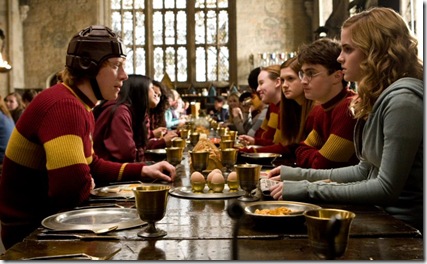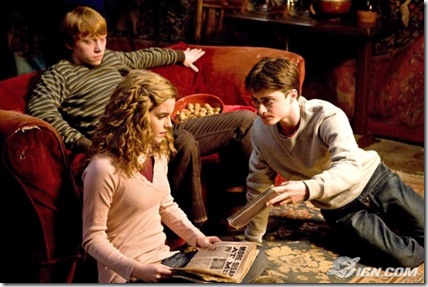How good is Harry Potter and the Half-Blood Prince? When the movie ended, I still had a third of my drink [the large one] left. That’s happened maybe half-a-dozen times over the last decade, so it’s a pretty good indicator of how engrossed I was in the film.
Steve Kloves has once again divined the essence of the novel and taken the key events and played to them, while adding and subtracting as he saw fit. The result is a film that is nowhere near being a slavish adaptation, yet remains completely faithful to the spirit of the source material.
There are big events here that take up what seems like an insignificant time onscreen – until you realize that you only need a few moments to provide all the detail that took up pages in the book. This is especially true of the book’s – and the film’s – biggest event. You know the one I mean, but for the sake of sparing some hypothetical newbie the major spoiler, we’ll just pretend that there will be many viewers who come into the film cold.
Kloves made the excellent decision to play up the teen hormones to as great a degree as the danger. Romance is as terrifying to teens as any monster – at least when they’re experiencing it for the first or second time in their lives. Watching Hermione suffer as Ron [Rupert Grint] snogs Lavender Brown [Jessie Cave] is as hard as watching Death Eaters attacking muggles – or Bellatrix Lestrange [Helena Bonham Carter] cutting loose on Hogwarts.
When Ron and Harry Daniel Radcliffe] talk about what Ginny might see in Dean Thomas [or what he might see in her], it’s both funny and poignant because it’s how guys talk about that sort of thing at that age – and also, because we can see how Harry is beginning to feel about her. Another conversation along those lines, between Hermione and Harry – after Lavender has pounced on Ron – plays the same notes in a slightly different arrangement and to equally telling effect.
The addition of Jim Broadbent to the series, as Professor Horace Slughorn, is handled very well. In the book, he’s a collector of celebrity friends – usually in the form of former students – and here he “collects” Harry. In what has to be a good choice, Kloves and Yates present him as less of a hanger-on and more of a very competent potions instructor who is justifiably proud of his former students who have made good – if perhaps a little too quick to bask in their reflected glory. As Slughorn was written on the book, he would have been too repugnant onscreen.
Special mention should also be made of the way Tom Felton plays Draco Malfoy. Prior to Half-Blood Prince, Malfoy has been a bigot and a bully. Here, he is given an assignment by Voldemort and it’s of such magnitude that he goes through hell in his efforts to fulfill it. Felton makes Malfoy’s every conflicting emotion clear and, in so doing, makes him human, relatable and even a tiny bit sympathetic.
Director David Yates, who will finish out the series, knows exactly how play Kloves’ script. He knows when a comic moment needs to be quick and when it needs to be subtle or overt. He knows when to play a big moment as a big moment – and when it should stab quickly, suddenly and in a microsecond.
Harry Potter and the Half-Blood Prince is, after Alfonso Cuaron’s remarkable Prisoner of Azkaban, the best film in the series, thus far. It’s big when it needs to be and small when required. It’s the balance of huge moments and grand effects in a near perfect balance with small, but significant moments and subtle detail – as when the camera gives the tiniest of shakes each time Dumbledore [Michael Gambon] and Harry apparate. Like I said, it’s so good that I never even came close to finishing my drink.
P.S. Sorry about the Dr. Strange quote in the header, but it just felt right.
Final Grade: A

